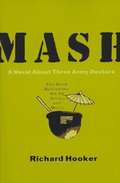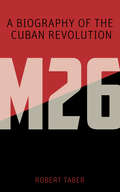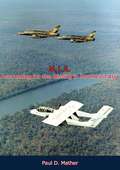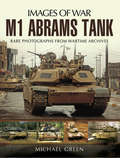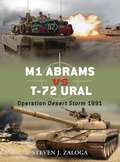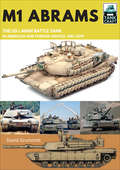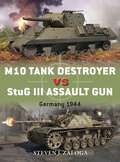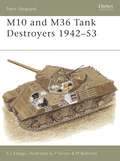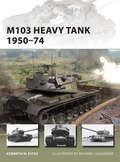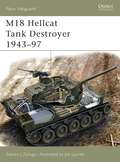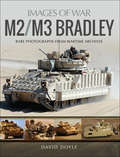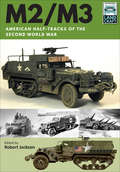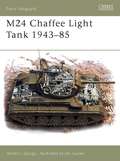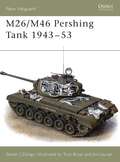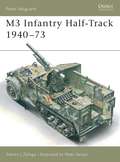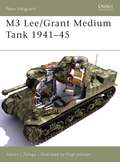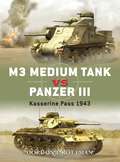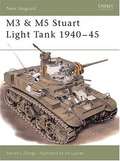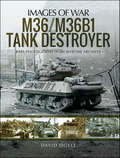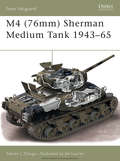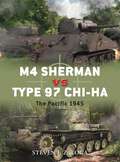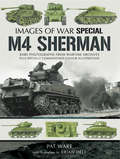- Table View
- List View
M*A*S*H: A Novel About Three Army Doctors
by Richard HookerBefore there were the movie and the television series, there was the novel that gave birth to such American immortals as Hawkeye and Trapper John, Hot Lips Houlihan, Frank Burns, Radar O'Reilly, and the rest of the 4077th MASH--a place like no place else in Korea or on earth. The doctors and nurses who worked in the Mobile Army Surgical Hospitals (MASH) during the Korean War were well trained, dedicated, and pushed to the brink. And they were young--too young to be doing what they had to do. As Richard Hooker writes in the Foreword, "A few flipped their lids, but most of them just raised hell, in a variety of ways and degrees." Meet the true-life heroes and lunatics who fought in the Korean War, and experience the martini-laced mornings, marathon hijinks, sexual escapades, and that perfectly corrupt football game that every fan of the movie will remember. It's also a story of hard work and skill in the face of enormous pressure and odds. Here is where it all began--the novel that made M *A *S *H a legend.
M*a*s*h Goes To Paris
by Richard Hooker William E. ButterworthWhen HAWKEYE, king of the links and surgeon extraordinaire TRAPPER JOHN, bon vivant of the operating room and so good with his hands HOT LIPS, who's discovered... well... religion RADAR, with his great new idea for a fast-food empire and the rest of the lunatic crew from M*A*S*H hit the sin city on the Seine, the French had better look out! Things happen fast, funny and furious when the inimitable ambassadors of goodwill and goonery arrive, bringing inevitable chaos in their wake.
M-26: A Biography of the Cuban Revolution
by Robert TaberM-26: A Biography of the Cuban Revolution, first published in 1961, is a reporter’s account of the overthrow of the Batista regime and Fidel Castro’s successful rise to power. Author Robert Taber, a correspondent for CBS, details the political and economic situation which helped foster the revolution, plus chronicles events of the revolution and his experiences while living with the guerrilla fighters in Cuba’s mountainous interior. M26 (the name is from an earlier unsuccessful uprising—Movimiento Revolucionario—led by Castro in July, 1953) is a valuable resource for anyone seeking a well-written account of this critical period in Cuba’s history.
M.I.A.: Accounting for the Missing in Southeast Asia
by Paul D. MatherAmong the numerous analyses of those missing in action in Southeast Asia, this study is the first to concentrate on the process whereby the US military tried to resolve each case. Much of the continuing controversy ignores or refuses to accept the fact that the US Government, through the Joint Casualty Resolution Center and other mechanisms, has made a thorough, sustained, good faith effort to determine the fate of every serviceman declared missing in action in that conflict. The author, who spent more than 15 years in Southeast Asia taking part in those endeavors, tells the story of this unique effort from the point of view of an informed insider.A member of the MIA search team from the early 1970s through the late 1980s, Paul Mather is well qualified to relate the history of this effort. He covers a wide range of topics, from field work at crash sites and personal interchanges with Vietnamese, Cambodian, Lao, and Thai officials, through the various international accords that governed the activities of the US investigatory teams. Although political changes in the United States alternately facilitated or hampered search efforts, the attempt to resolve every case never ceased. Colonel Mather faithfully records the efforts of individuals and organizations that played major roles in. this drama: congressional committees; the National League of Families; private citizens who made sincere efforts to help; senior government officials like General John Vessey, who headed a special full-accounting commission; military agencies such as the Joint Casualty Resolution Center and the Army’s Central Identification Laboratory; scoundrels and swindlers who exploited the tragedy for personal gain; and self-styled Rambos who acted on their own.This account should help to wrap up an especially emotional chapter of the Vietnam War. By telling how the process worked for almost two decades, it contributes to the full accounting desired by all.
M1 Abrams Tank (Images of War)
by Michael GreenThis pictorial history of the legendary M1 Abrams Tank illustrates its versatility and advancement from the Cold War Era to the present day. The M1 Abrams has proved itself to be the finest main battle tank in the world since its introduction into US Army service in 1981. It combines the ultimate balance between firepower, mobility and protection as demonstrated by its superior performance during the two Gulf Wars and in Afghanistan. It routed the Soviet equipment of Saddam Hussein's army and today remains the yardstick by which friends' and foes' MBTs are judged. As military expert Michael Green demonstrates in this illustrated history, the M1&’s versatility, and its continual modernization of weaponry armor and engineering, guarantees that it will remain the US Army's spearpoint for years to come. With its comprehensive collection of images and authoritative text, this volume is an ideal resource for information on M1 Abrams Tank design and combat operations.
M1 Abrams vs T-72 Ural: Operation Desert Storm 1991
by Steven J. Zaloga Jim LaurierThe Gulf War bore witness to a number of deadly encounters between these two great adversaries. Heavily armored, highly mobile and capable of killing at over 2500m the M1 Abrams is, to this day, a veritable fighting machine. Superior to both Iraq's Soviet era T-55 and T-62 tanks, nearly all sources claim that no Abrams tank has ever been destroyed by enemy fire. Despite entering service in 1980, the M1 Abrams remained untested in combat until the Gulf War in 1991, where it was to be confronted by its archenemy the Iraqi-assembled Soviet-designed T-72. Entering production in 1971, the T-72 arguably outstripped its contemporaries in a balance of mobility, protection and firepower. By the time of Operation Desert Storm, however, the tables had turned and the tank suffered due to low quality ammunition and poorly trained crews. In this fascinating study, Steven Zaloga pits these two great fighting machines against one another, plotting the development of the Cold War until both tanks met in combat in the deserts of Iraq and Kuwait. From the Trade Paperback edition.
M1 Abrams: Rare Photographs From Wartime Archives (Images of War)
by David DoyleA photographic history of the principal main battle tank of the modern US military. Conceived to counter the threat of a massive Soviet armored incursion in Europe, the M1 Abrams tank gained considerable fame during the Persian Gulf War of 1991, and its combat record has continued to climb. With such a long service life, the Abrams has undergone continual improvements and upgrades, which are illustrated in great detail in this volume. The unique features of the various models are detailed in stunning color photos, and the combat use of these fearsome vehicles is richly illustrated through previously unpublished photos. The story of the Abrams begins in the late 1960s when the threat of Soviet Armor developments forced the U.S. to look for a suitable replacement for the M60 series. A joint venture between the U.S. and West Germany to build a suitable common Main Battle Tank brought about the unorthodox and terribly expensive MBT70. It never saw series production. When this program was cancelled in 1970, a quest for a more cost-effective tank was begun. The constant development, upgrade, and conversion of the series have kept the Abrams at the forefront of main battle tank technology—and it has proven itself on the battlefield time and time again. This book, filled with rare archival photos, takes us through decades of its remarkable history, including improvements to its armor, transmission, and engine; the addition of an integrated nuclear, biological, and chemical system; the installation of a layer of depleted uranium and interior blast doors to protect the crew, and more.
M1 Abrams: The US's Main Battle Tank in American and Foreign Service, 1981–2019 (Tank Craft)
by David GrummittA history of the iconic vehicle: &“This modeler's delight showcases the M1 and its variations with all sorts of camouflage schemes.&” —Historical Miniatures Gaming Society Since its introduction in 1981, at the height of the Cold War, the Abrams main battle tank has been one of the most visible symbols of American military power, and it is the fascinating subject of this heavily illustrated historical and modeling guide in the TankCraft series by David Grummitt. Designed to meet head-on the massed tank forces of the Warsaw Pact, its combat debut actually came in a different scenario in 1991, during the First Gulf War. Since then it has served in a peacekeeping role in the former Yugoslavia and seen combat in Iraq, Afghanistan, and Yemen. It has gone through a series of modifications and modernizations that see it set to remain the backbone of the US Army until at least 2050. As well as charting the development and combat history of the vehicle, this book is illustrated throughout with color photos and specially commissioned color profiles. Five different models, covering the service history of the Abrams, are featured, as is a modeler&’s guide to the existing kits and accessories in the all the popular scales.
M1 Abrams: The US's Main Battle Tank in American and Foreign Service, 1981–2019 (Tank Craft)
by David GrummittA history of the iconic vehicle: &“This modeler's delight showcases the M1 and its variations with all sorts of camouflage schemes.&” —Historical Miniatures Gaming Society Since its introduction in 1981, at the height of the Cold War, the Abrams main battle tank has been one of the most visible symbols of American military power, and it is the fascinating subject of this heavily illustrated historical and modeling guide in the TankCraft series by David Grummitt. Designed to meet head-on the massed tank forces of the Warsaw Pact, its combat debut actually came in a different scenario in 1991, during the First Gulf War. Since then it has served in a peacekeeping role in the former Yugoslavia and seen combat in Iraq, Afghanistan, and Yemen. It has gone through a series of modifications and modernizations that see it set to remain the backbone of the US Army until at least 2050. As well as charting the development and combat history of the vehicle, this book is illustrated throughout with color photos and specially commissioned color profiles. Five different models, covering the service history of the Abrams, are featured, as is a modeler&’s guide to the existing kits and accessories in the all the popular scales.
M10 Tank Destroyer vs StuG III Assault Gun
by Steven Zaloga Richard ChasemoreAlthough tanks like the Sherman and Panther captured the headlines, the Allies' M10 tank destroyer and the Germans' Sturmgeschütz (StuG) III were the unsung workhorses of the northwest European battlefields of 1944-45. While their mission was not principally fighting one another, their widespread use ensured their frequent encounters, from the Normandy bocage to the rubble-strewn streets of Aachen. The StuG III was the quintessential assault gun: a low-slung, heavily armored, turretless vehicle intended to provide direct-fire support for infantry formations. It was a jack of all trades, being used both for the traditional direct-fire role, but also increasingly for antitank defense; when its armament was improved from a short 75mm gun to the better-known long 75mm gun, it reached its pinnacle and remained largely unchanged from 1943 to 1945. It proved exceptionally valuable in Normandy as its low profile and excellent armament made it a useful infantry support weapon while at the same time it had more than adequate firepower to destroy standard Allied tanks such as the Sherman.The M10 3in Gun Motor Carriage was originally developed as a tank destroyer. It was based on the Sherman tank chassis but with less armor and a more powerful gun. By 1944, however, its 3in gun proved ineffectual against the most thickly armored German tanks such as the Panther and Tiger. As a result, by 1944, the US Army's M10 battalions were usually deployed in support of US infantry divisions to conduct direct-fire support. Essentially, the M10 became the US Army's principal assault gun in the 1944-45 ETO campaign, whether intended for this role or not.Widely deployed in roles their designers had not envisaged, these two armored fighting vehicles clashed repeatedly during the 11-month campaign that saw the Allies advance from Normandy to the heart of the Reich. Fully illustrated with specially commissioned artwork, this is the story of their confrontation at the height of World War II.
M10 and M36 Tank Destroyers 1942-53
by Steven Zaloga Peter SarsonThe US Army had a unique tactical doctrine during World War II, placing the emphasis for tank fighting on its Tank Destroyer Command whose main early-war vehicle was the M10 3-inch Gun Motor Carriage, based on the reliable M4A2 Sherman tank chassis. This durable and versatile vehicle saw combat service from the North Africa campaign in 1943. By 1944, its gun was not powerful enough and it was rearmed with the new 90 mm gun, becoming the M36 90mm Gun Motor Carriage. This book details one of the only US armoured vehicles capable of dealing with the Panther and Tiger during the Battle of the Bulge.
M103 Heavy Tank 1950-74
by Richard Chasemore Kenneth EstesThe T43 design represented the pinnacle of U.S. Army tank engineering of the late 1940s, with its cast elliptical hull and turret, Continental AV-1790 engine, cross-drive transmission, and torsion bar suspension. A range-finder and mechanical computer directed a powerful 120mm main gun in a novel electro-hydraulic turret, among other features. The heavy tank proved fairly popular with its crews, who above all respected the powerful armament it carried. Many challenges to the crewmen were taken on with a sense of pride. Typical was the job of the second loader to hand-ram both the projectile (positioned by the first loader at the breech) and the propellant cartridge into the chamber in a single movement, all within the confines of a narrow turret. The outbreak of war in Korea brought a rush order in December 1950 which led to a complete production run of 300 vehicles, considered sufficient for Army and Marine Corps requirements. As might have been expected from the rush to production, the T43E1 failed its initial trials at Ft. Knox, mostly for erratic gun controls and poor ballistic performance of the projectiles. A modification program (of over 100 discrepancies) resulted in the standardization of the T43E1 as the 120mm gun combat tank, M103 in 1956. After 1951, the Marine Corps alone retained confidence in the heavy tank program, investing its scarce funds in the improvements necessary to bring about its fielding after a hurried production run in midst of the 'tank crisis' of the year 1950-51. Without the Marine Corps' determination to bring the M103 to operational status, it seems clear that the 300 vehicles would have languished in storage before their eventual disposal. The correctness of the Marine Corps support of the M103 tank was in no small way acknowledged by the Army's borrowing of 72 M103A1 improved USMC tanks necessary for its single heavy tank battalion in Germany. No other weapon system, before the era of antitank missiles, could guarantee the destruction of the Russian heavies, which continued their service through the late 1960s. The eventual retirement of the M103 in 1972, over 20 years after manufacture and after 14 years of operational service, demonstrated the soundness of its engineering and fulfillment of its designed role. It may have been the unwanted 'ugly duckling' of the Army, which refrained from naming the M103 alone of all its postwar tanks. For the Marine Corps, it served the purpose defined for it in 1949 until the automotive and weapons technology of the United States could produce viable alternatives.
M18 Hellcat Tank Destroyer 1943-97
by Steven Zaloga Jim LaurierThe M18 76mm Gun Motor Carriage was developed for the US Army's Tank Destroyer Command. It was the only tank destroyer deployed during World War II actually based on their requirements for speed and firepower. This book examines the development of this vehicle, the controversies over the need for high-speed tank destroyers, and its actual performance during World War II. Special emphasis is placed on examining its performance in its intended mission. Coverage also includes derivative vehicles of the M18 such as the M39 armored utility vehicle.
M2/M3 Bradley (Images of War)
by David DoyleThrough hundreds of color photos, the bulk previously unpublished, Images of War: M2 Bradley explores Americas premier Infantry Fighting Vehicle in an unprecedented level of detail. Go inside and out the modern-day icon, then ride it into battle through they myriad of photos presented in this book. See why Bradley remains one of the most formidable armored combat vehicles of its class, even as it logs over 35 years of service.The Bradley Fighting Vehicle, made famous through extensive media coverage of the wars in Iraq and Afghanistan, is given an in-depth examination in this brand new volume. Drawing on the lessons learned in Vietnam, the Bradley was built to provide a highly mobile platform from which infantry could be inserted into the battlefield, and from which the infantry could operate. Its use soon expanded to that of a scout vehicle with anti-tank capability. Despite initial criticism from Congress, the Bradley proved itself very capable on the battlefield, destroying more Iraqi armored vehicles than did the famed Abrams tanks. Through extensive photo coverage, most never before published, this book explores the many variations of the Bradley, including the heavily armed M270 Multiple Launch Rocket System.
M2/M3: American Half-tracks of the Second World War (LandCraft #2)
by Robert JacksonA history of these versatile vehicles, with photos and useful information for modelers. Among the most successful armored vehicles produced by American industry—known as the Arsenal of Democracy—during the Second World War were the M2 and M3 half-tracks. They served on every battlefront and were as recognizable as other famous American wartime vehicles like the Sherman and the Jeep, and around 40,000 were produced between 1941 and 1945. They were easy to assemble, operate and maintain, and their versatility allowed them to fulfill a variety of purposes. This volume traces the design, development, and manufacturing history of the M2/M3 and describes its operational role within the Allied armies. A selection of archive photographs showing the M2/M3 in action gives a graphic impression of how adaptable these vehicles were and records the range of equipment they could carry. The book is also an excellent source for the modeler, providing details of available kits, together with specially commissioned color profiles demonstrating how the M2/M3 used by different units and armies appeared.
M24 Chaffee Light Tank, 1943-85
by Steven J. ZalogaThe history of US light tanks during World War II is a chequered one. The Light Battalions of US Armored Divisions were initially filled with M3A1 and M5 Stuart tanks, however, on the battlefields of North Africa it was realised that these were disastrously under armoured and gunned, and a replacement, or the abandonment of light tank doctrine, was desperately needed. It wasn't until the last few months of WWII that the M24 Chaffee came into service and it was extensively used in combat from the Battle of the Bulge to the final campaigns in Germany. This book will trace the history of this design, its combat record in World War II, its many variants, and its extensive combat record post 1945.
M26/M46 Pershing Tank 1943-53
by Steven Zaloga Tony BryanFrom the moment that the M4 Sherman had been matched against German Panther and Tiger tanks, the American tank crews had known that their vehicles were outclassed by the opposition. What was needed was a more powerful tank, more heavily armed and armored, that could take-on the powerful German panzers on a more equal footing. Although it took time to develop by the latter months of the war numbers of M26 Pershing tanks were reaching the frontline US armored units. Well armored and with a powerful 90mm gun the Pershing was a match for any tank in the German order of battle.
M3 Infantry Half-Track 1940-73
by Steven Zaloga Peter SarsonAs armoured warfare tactics matured, mechanised infantry became a key ingredient in what is now called 'combined arms' doctrine. For the US Army of World War 2, the most important technical aspect of infantry mechanisation was the development of the M3 half-track personnel carrier. Steven Zaloga guides the reader through the early 1930s development of the half-track, its first deployment in action in the Philippines in 1941 and its varied and vital role in international deployments since World War 2. This authoritative text also examines the operators of half-tracks and the troops that they carried.
M3 Lee/Grant Medium Tank 1941-45
by Hugh Johnson Steven ZalogaThe highly successful 'stop-gap' M3 medium tank was designed in 1941, and as adequate turret casting facilities were not yet ready, the M3 used an unusual armament configuration patterned after a French tank. British lend-lease demands led to the design of a second turret type with the US version called the Lee and the British version the Grant. It could penetrate Panzer armor, and its explosive firepower was excellent for dealing with German anti-tank guns. This book covers the design, development, service and variants of a vehicle that was the backbone of many World War II forces.
M3 Medium Tank vs Panzer III
by Gordon Rottman Ian Palmer Giuseppe Rava"...the first-person perspectives offered by Kirby and Köhler put this book on my recommended books list. These personal experiences definitely stirred some interest for me to research more on the design, evolution, and field performance of each of the two tanks.- C. Peter Chen, World War II Database (July 2008)Smarting from their defeat at El Alamein and with directives to save the North African campaign, Rommel's battle-hardened armored divisions confronted a fresh opponent in the form of the newly arrived Americans. This would be a duel between the stalwart of the Wehrmacht armored divisions - the Panzerkampfwagen III - and the American's as yet untested first armored division. In reality both would prove unequal to the task as they floundered amidst the rugged hills and ravines of the Tunisian landscape. This book charts the design and development of these two disparate rivals - their vastly different armament and armor as well as their tactical concepts. Mutually hampered by the climate, terrain, and lack of experience, this was a desperate struggle for supremacy. Moreover, it was a duel with far-reaching implications. For the Americans it was their first baptism of fire and the outcome would determine their future war strategy. For the Germans, this was the final throw of the dice to regain the overwhelming superiority they had enjoyed during the first years of the war. Analyzing the strengths and weaknesses of these two deadly opponents, this book explores the successes and failures of the Grant and Panzer III as they clashed at the critical battles of North Africa. Moreover it is an insight into the lives of the tank crews themselves as they struggled with the twin horrors of tank warfare and the fight for survival amidst some of the most inhospitable terrain on earth.
M3 and M5 Stuart Light Tank, 1940-45
by Steven J. ZalogaThe M3 and M5 family of light tanks were the culmination of American tank development of the 1930s. By the time of the outbreak of the World War II, they were approaching obsolescence, as tank forces in Europe were shifting from light to medium tanks as the main element of their armored forces. First entering combat in the autumn of 1941 in the Western Desert with the British Army, the Stuart quickly proved its inadequacies. The M3 and M5 light tanks proved more suitable in the Pacific theater than in Europe, and fought successfully in many of the major battles including Guadalcanal, Tarawa and Peleliu. This title narrates this distinctive and unusual fighting vehicle's history.
M36/M36B1 Tank Destroyer (Images of War)
by David DoyleGoing into WWII, the prevailing strategy of the US command was that tanks were not to be used to engage enemy tanks in combat. Rather, tanks were to be the armored spearhead to breach enemy positions. Enemy tanks were to be dealt with by specialized weapons, aptly named tank destroyers. While the 3-inch weapon of the M10 was superior to that found on earlier US tank destroyers, it was still found to be inadequate against the ever-increasing weight of German armor. An even larger gun, the 90mm M3, was placed in a new, bigger open-topped turret on 100 new hulls purpose built for this, and by remanufacturing M10A1s, primarily from US-based training units. As the supply of these chassis was depleted, additional vehicles were created by converting Diesel-powered M10s, resulting in the M36B2. The M36B1 was built from the ground-up as a tank destroyer, using a hull based on that of the M4A3 but featuring a standard M36 turret. Examination of rare surviving vehicles indicates that the M36B1 hulls were manufactured expressly for this purpose, and were not merely M4A3 hulls that were converted. While US antitank doctrine changed, rendering all the tank destroyers obsolete post WWII, many of these vehicles were supplied to other nations, and in fact some survived as combat vehicles into the 21st century.
M4 (76mm) Sherman Medium Tank 1943-65
by Steven Zaloga Jim LaurierThe M4 Sherman tank was the mainstay of the Western allies between 1942 and 1945. Fast and modern it was a big success and was transported as far afield as Russia and North Africa. The American Chief of Staff claimed in November 1943 it was 'hailed widely as the best tank on the battlefield today...'. However, by the Normandy invasion of June 1944 this was not the case: the new German heavy tanks such as the Panther and Tiger were completely outclassing the Sherman. This title covers the M4 version armed with the 76 mm gun, examining developments such as the HVSS suspension, using much new archive material.
M4 Sherman vs Type 97 Chi-Ha
by Steven Zaloga Richard ChasemoreWhile the Pacific campaign is not well known as a theater for tank combat, the US Army deployed nearly a third of its tank battalions to the Pacific, and Japan was among the top five tank manufacturers during the war. The obscurity of Pacific tank battles largely hinged on the tactics used in the Pacific theater due to terrain. Tanks were generally used as infantry support weapons, and the terrain precluded the use of tanks in maneuver warfare that might have led to large scale tank-vs.-tank battles. This book begins by surveying the early tank battles in the Pacific between US and Japanese forces, starting with the first encounters in the Philippines in 1941 between US M3 Stuart light tanks and Japanese Type 95 tanks. Tank-vs.-tank action became more common in 1944 as both sides poured larger numbers of tanks into the combat zone. The largest Japanese tank attack of war took place in July 1944 on Saipan, but there were frequent tank encounters in the ensuing months on Guam, and Peleliu. The Philippines saw the largest Japanese tank deployment of the war, with the Japanese sending a tank division to Luzon in 1944. This led to extensive clashes with US army forces, sometimes pitting tank vs. tank, but often a mixture of tanks, infantry anti-tank weapons, and even self-propelled guns. The last two campaigns of the war on Iwo Jima and Okinawa saw tank use on the part of both sides, the Japanese finally concluding that "the fight against the US Army is a fight against his M4 tanks". This book will take a look at the two best tanks of the Pacific campaign. On the American side, the M4A3 Sherman medium tank was used by both the US Army and US Marine Corps. On the Japanese side, the Type 97-kai Shinhoto Chi-Ha was the best tank to see combat. This was a very uneven contest, which is the main reason that in 1944 on Luzon, the Japanese were so reluctant to deploy the Chi-ha against the Sherman and preferred to use them as dug-in pillboxes. The book illustrations will follow the usual Duel pattern with profile illustrations of the Type 97-kai Shinhoto Chi-ha and M4A3, views showing the ammunition of both types, interior illustrations showing the turret layout in both types, and a Battlescene showing the Type 97-kai in combat against US armor.
M4 Sherman: Rare Photographs From Wartime Archives Plus Specially Commissioned Colored Illustrations (Images of War Special)
by Pat WareThis pictorial history of the legendary American tank combines color photographs, commissioned illustrations and authoritative information. The M4 Sherman was one of the most famous tanks of the Second World War. Produced in greater numbers than any other Allied tank, it fought on every front, and continued to serve as a front-line fighting vehicle in the Korean War, the Arab-Israeli wars, and the Indo-Pakistani wars. This detailed history of the Sherman covers its design and development, its technical specifications, the many variants that were produced, and its operational role in conflicts across the world. While the Sherman outclassed the older German tanks it encountered when it first went into combat in 1942, it was vulnerable to the later German medium and heavy tanks such as the Panther, Tiger I, and Tiger II. Yet the Sherman was ultimately more effective than these superior German tanks because it was reliable, durable, cheaper to build, and extremely adaptable. The Sherman was converted into a tank-destroyer, an amphibious tank, a recovery vehicle, a mine-flail, a personnel carrier—and, after the Second World War, it was developed to confront more modern tanks in combat. Pat Ware's expert account of this remarkable fighting vehicle is accompanied by a series of color plates showing the main variants of the design as well as common ancillary equipment and unit markings. This is an essential reference work for World War II buffs and armored warfare enthusiasts.
